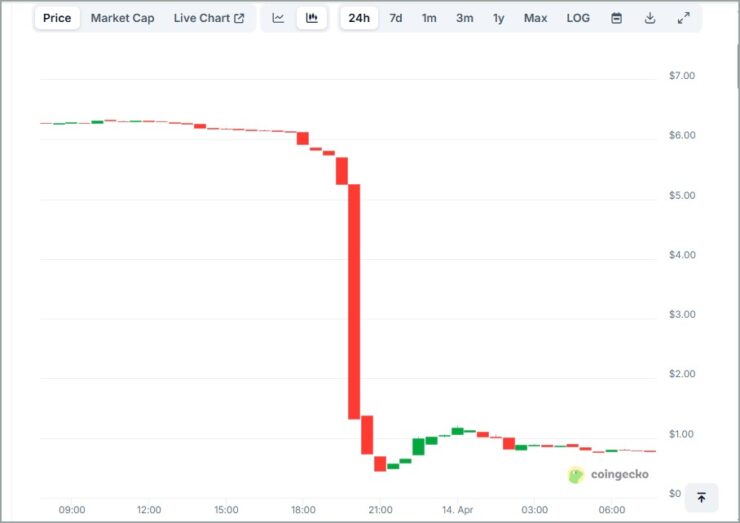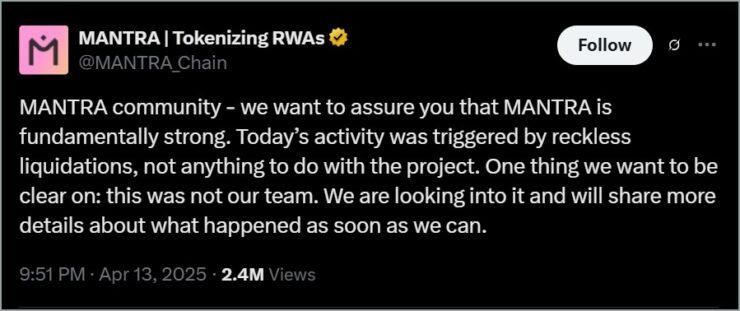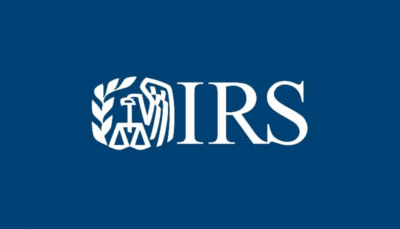The MANTRA blockchain ecosystem suffered a dramatic blow on Sunday, as its native token, OM, plummeted by over 90% in less than two hours. The slide began gradually, with a 10% decline observed between 5:20 p.m. and 6:20 p.m. UTC, but quickly spiraled into a catastrophic collapse. Within minutes, OM fell from $5.21 to approximately $0.50, catching investors completely off guard and wiping out hundreds of millions in market capitalization.

Panic quickly spread as community members scrambled to understand the cause. The project’s official Telegram group became temporarily inaccessible, adding to the confusion. MANTRA community lead Dustin McDaniel called for calm, stating the team was still investigating and that he had no immediate insight into the incident. However, his reassurances did little to stabilize sentiment as fears of insider manipulation or technical failure gained traction.
Rug Pull Allegations and Community Outrage
As OM’s value nosedived, rumors erupted across social media platforms. Many pointed fingers at an alleged group referred to as the “Kabal team,” accusing them of conducting a coordinated dump of OM tokens. Though no specific identities have been confirmed, several users suggested the group had close ties to insiders at MANTRA. One post read bluntly, “The Kabal team just rugged everyone. Project is dead.”
In an official statement, the MANTRA team attempted to shift blame, citing “reckless liquidations” as the root cause. Co-founder John Patrick Mullin expanded on this narrative, claiming that the collapse was triggered by a “massive forced liquidation from a large OM investor on a centralized exchange.” Mullin added that the team was actively working to stabilize the situation and restore confidence.

Blockchain data from etherscan has only deepened the intrigue. According to on-chain analytics, a wallet associated with MANTRA DAO burned over 21 million OM tokens—valued at $132 million—just days before the crash. While token burns are often viewed as bullish due to reduced supply, the timing has sparked suspicion. Some community members have speculated that the burn could have been part of a broader strategy to manipulate supply dynamics ahead of the collapse. In total, more than 84 million OM tokens have been burned to date, equating to over $500 million in value.
Governance Model Under Scrutiny
The crash has reignited long-simmering concerns over MANTRA’s governance structure. For months, critics have questioned the concentration of token supply and the project’s voting framework, warning of potential insider influence and lack of decentralization safeguards. Many now view the price collapse not as an isolated incident, but as the culmination of systemic flaws in project design and decision-making processes.
In response, Mullin defended the project’s history and resilience, noting that OM has been circulating since August 2020. Yet for many investors, longevity is not enough. In an industry built on transparency and decentralization, those ideals must be continuously demonstrated—not merely cited.
The timing of the collapse is particularly ironic, given that MANTRA had recently garnered attention for its real-world asset tokenization initiatives. Just weeks ago, Mullin touted a major partnership with Dubai-based DAMAC Group, claiming the firm would tokenize over $1 billion in real estate using MANTRA’s infrastructure. While the collaboration signaled serious ambitions beyond speculative trading, the fallout from Sunday’s crash threatens to undermine those aspirations and raise new doubts about the platform’s credibility.
Quick Facts
- MANTRA’s native token OM plunged over 90% in under two hours, falling from $5.21 to around $0.50.
- Community speculation points to insider dumping, while the project blames forced liquidations on centralized exchanges.
- Blockchain data shows over 21 million OM tokens were burned days before the crash, fueling suspicions around timing and transparency.
- The collapse has resurfaced earlier concerns about MANTRA’s governance model and token supply control, despite recent real-world asset partnerships with firms like DAMAC Group.





